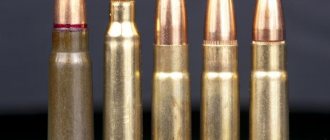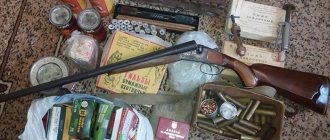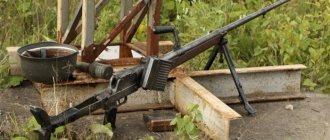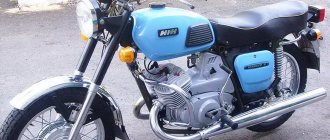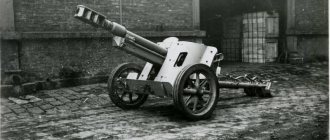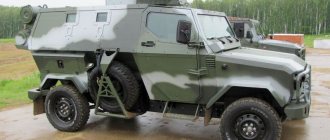What are the calibers of hunting rifles?
The answer is simple - the diameter of the bore. Correct, but to a first approximation. The fact is that the barrel bore has a complex profile. But we’ll come back to this a little later.
When talking about shotguns, we usually say: “12-gauge, 16-gauge, 20-gauge, 28-gauge, or 32-gauge shotgun.” At the same time, we know for sure that a 28-caliber shotgun has a thinner bore than a 12-gauge shotgun. It is clear that these numbers are not units of length. The caliber rating (4-gauge, 8-gauge, 10-gauge, 12-gauge, etc.) corresponds to the number of round bullets cast from an English pound of lead.
The nomenclature of rifled weapons is no simpler. The famous Russian Mosin rifle is called a three-line rifle, and the caliber of the Simonov self-loading carbine is indicated in millimeters - 7.62, with completely identical barrel bore diameters.
Digital and thermal imaging night sights for smooth-bore weapons
Digital
Despite its not the cheapest price (a first-generation sight can be purchased for half the price of a digital one), the digital has undeniable advantages specifically for use with powerful smoothbore guns:
- The digital sight is not afraid of the recoil of powerful calibers, including Magnum class cartridges.
- Variable types of aiming reticle, including your own (for example, the circle of the highest probability of a bullet hitting).
- Possibility of creating sighting profiles, for example, at different distances.
- Digital zoom. Moreover, as the scale changes, the grid also increases.
- Frame-in-frame mode - for fast and very accurate aiming.
- High image quality at IR illumination operating distances (100 meters) comparable to sights with image intensifier tubes of generation 2+ and higher.
An important advantage is also the ability to use a digital night sight during the day. This is especially convenient for target practice.
Expensive models of digital sights (for example, Pulsar Digisight Ultra N455) also have a built-in laser rangefinder, which shows the distance to the target directly on the screen. This is especially convenient for making amendments. But if you don’t plan to shoot at long distances and at temperatures less than -15°C, then you can get by with the simplest digital camera like the Photon RT 4.6×42. You can read more about digital sights in this article.
| The Yukon Sightline N455 digital night vision sight eliminates the “diseases” of the first digital cameras, such as instability of batteries and display at low temperatures and a small viewing angle. The clear, high-contrast image of the sight is much better than any sight with a 1st generation image intensifier at distances up to 150 meters. Read more.. |
Thermal imaging
Thermal imagers are much more expensive. As an alternative to a budget thermal sight, we recommend using an inexpensive first-generation sight from those described above, and for tracking game, buying the simplest thermal imaging “peeper”, which costs about 100 thousand rubles. For the most modern thermal imaging sight you will have to pay more than a million.
Often, when choosing a weapon body kit and equipment for hunting, they are guided not so much by the logic of using uniforms, but by the desire to have the most technologically advanced devices. In this case, the most “balanced” choice would be the Dedal T2.380 Hunter LRF thermal imaging sight, the laser rangefinder of which determines the distance to the target and will allow you to fire a shot at a distance proven during shooting and the maximum possible for your smooth-bore weapon.
Shotgun calibers
Let's try to figure it out first with smooth-bore weapons. Now in Russia they produce guns of only five named calibers.
But earlier, in addition to them, guns of 4, 8, 10 and 24 calibers were produced. The numbers denoting these calibers correspond to the whole number of round bullets produced from one English (trade) pound of lead (453.6 g).
This definition allows us to create a simple but useful equation: K x M = 453.6 g, where K is the caliber of the barrel, M is the mass of a round bullet having a diameter equal to the diameter of the bore.
This equation makes it possible to calculate three important parameters:
- The mass of a round bullet of any caliber is obtained by dividing 453.6 g by caliber;
- If we substitute the mass of the bullet, expressed in terms of the volume of the ball and the density of lead (11.34 g/cm3), it is easy to calculate the barrel diameter (in mm) for any caliber. It is equal to 42.5/(cube root of caliber). The caliber can be determined if the bore diameter is known;
- The caliber is equal to the third power of the ratio 42.5 / (barrel bore diameter in mm).
History of calibers
At the beginning of the last century, all integer calibers (4, 5, 6, 7, and so on up to 36) were in use. It seems very strange that such an irrational designation of calibers has survived to this day.
After all, designations of calibers in linear units, especially decimal ones, would be incomparably simpler and clearer. However, our general inertia is very great.
At the beginning of the 19th century, Napoleon Bonaparte tried to introduce a definition of calibers in terms of the number of bullets along the diameter of the barrel, which is obtained not from a pound, but from a kilogram of lead. French guns of that period occasionally show traces of that reform. A 12-gauge shotgun was designated 40 in Napoleonic style.
Shotgun bore profile
From the breech there is a chamber - a socket for a cartridge. The chamber begins with a groove under the rim of the sleeve. Its total depth for a 12-gauge shotgun is 1.9 mm. The first half is a cylinder with a diameter of 22.5 mm, the second is a cone with an apex angle of about 80 degrees.
This groove under the rim of the cartridge case not only positions the bottom of the cartridge case in the plane of the breech cut of the barrels, but also, with the help of a cone, centers it in the chamber. The chamber is a truncated cone, expanding towards the breech by 0.3 mm. This is necessary for free removal of the spent cartridge case.
The length of the chamber must match the length of the cartridge case. Longer cartridges lead to unacceptably high pressures of powder gases in the barrel when fired; cartridges that are shorter than the chamber lead to uneven pellet and sharpness and, in addition, ruin the chambers.
Shells for shotguns
Our industry produces guns for cartridges with lengths of 70 and 76.2 mm. These dimensions are based on the inch system. In the world, chambers are made from 51 to 89 mm long. A generally accepted standard requires that the length of the cartridge case in the unwound state be marked on the finished cartridge.
In addition, when indicating the caliber of a smooth-bore weapon, the length of the cartridge case is written through a slash. For example. 12/70 or 20/76. Some hunters have a misconception that in order to easily remove metal cartridges from the chamber, they must almost dangle in it. In fact, the brass sleeve in the chamber must fit tightly so that when fired, its deformation does not exceed the elastic limit. If a loose chamber allows the case to reach the limits of plastic, irreversible deformation, it will be very difficult to remove it.
In order for a gun to be able to fire using cartridges of different designs (with different wall thicknesses), a transition cone or projectile entrance follows the chamber. Cases made from different materials have different internal diameters of the barrels, which differ from the diameter of the barrel bore. The purpose of the transition cone is to prevent the breakthrough of powder gases either into the shot charge or into the gap between the chamber and the sleeve when the projectile passes from the chamber to the barrel.
To prevent such a breakthrough, it is necessary that the height of the felt wad be at least one and a half times greater than the length of the transition cone. Its profile varies, but the length rarely exceeds 10 mm. Behind the transition cone the actual barrel channel begins, which continues to the muzzle device. In rare cases when it is not present, the channel continues to the muzzle without a significant change in diameter.
Thus, the caliber in a smoothbore gun is the internal diameter of the barrel from the projectile entrance to the muzzle device.
Practical difficulties
Now in theory everything seems certain, but in practice there are a couple of complications. Each company has its own tool sizes and equipment for processing barrel bores of each caliber. Even in our country of complete standardization, the Tula Arms Plant produces 12-gauge shotguns with a bore diameter of 18.5-18.7 mm, and the mechanical plant in Izhevsk produces 18.2-18.45 mm.
Moreover, practically the barrel channels are not a strict cylinder, but a truncated cone. From the chamber to the muzzle they taper slightly. This expansion in the breech occurs naturally. Any deep hole on the entry side of the processing tools becomes slightly wider. However, this imperfection also plays a positive role.
Moving from the chamber, the wad, while somewhat abraded, still does not stop working (preventing breakthrough of powder gases) because the diameter of the channel decreases. This reasoning fully applies to both the traditional felt wad and the polyethylene seal wad.
For the sake of fairness, it should be noted that the best piece gunsmiths make special efforts, and their barrels between the transition cone and the muzzle device really have a constant diameter, they are a real cylinder.
In addition, sometimes a small cone is specially made in the first third of the channel (from the breech).
Returning to the definition of the caliber of a shot barrel, we must understand some conventions of this parameter.
Typically, shotguns have choke tubes, the main purpose of which is to finally form the shotgun. Barrels without choke constrictions are rare in smoothbore shotguns, although they tend to shoot better with zeros. Such trunks are called “cylinders”.
Shot speed
Speed is much easier to analyze than a balance or leash and can be measured using a device. According to Blazek, for barrels ranging from 20 to 32 inches in length—the vast majority of hunting rifles—the increase in velocity is about 3 meters per second for every 5 centimeters of barrel length for standard loads, and almost 4.5 meters per second for 5 centimeters in length for magnum cartridges. So the difference between 20 and 32 inch barrels will be 18 meters per second for weak sporting loads - a difference that can hardly be called significant even in extreme cases.
But I wanted to test the theoretical calculations using instruments, so I assembled 20- and 12-gauge shotguns with barrels ranging from 24 to 28 inches long. I used the same ammo in each gun (Winchester AA Super Sport for 12 gauge, Baschieri & Pellagri Dove & Quail for 20 gauge), and all barrels in the test had a "pressure cylinder" choke to improve stability. The speed was measured at a distance of 30 centimeters from the muzzle using a special device. Here are the results:
As you can see, the velocity doesn't change much with barrel length.
What is a choke and what is it for?
The most common form of constriction is called a “choke.” From the muzzle side, it is a cylinder, the longer the greater the narrowing.
- A full 12 gauge choke is 18mm long. It mates with the main channel with a sloping conical surface (taper 1:120);
- The payday has a cylindrical part length of 10 mm.
Let's first define the concept of "chok". This narrowing of the shotgun bore is located near the muzzle. This narrowing is very rarely made by more than 40 thousandths of an inch (in the metric system - 1.01 mm). Each "thousandth" can be considered as a unit of reduction.
You can read more about marking checks in the article: “Marking replaceable chokes.”
The barrels of guns intended for shooting on a round platform have wider chokes: from 10 thousandths to a strict cylinder. High-end shotguns for this exercise are sometimes made with a choke drill, but on the muzzle side a “bell” of 10-15 thousandths of an inch is made.
Currently, many manufacturers of hunting and sporting weapons equip their weapons with replaceable chokes, which are light tubes that are screwed into the barrel from the muzzle side. A special key is included for this purpose.
Choke shapes
Replaceable chokes are sometimes made in the form of barrel extensions, usually not exceeding 150 mm. However, the famous French one made a real revolution by producing a series of barrel extensions for semi-automatic shotguns with a length of 820 mm.
Designation of chokes size
There are different options for designating the size of chokes (there is no general standard yet). One of them is to use asterisks: * - full choke, ** - 3/4 choke, *** - half choke, **** - quarter choke or cylinder.
Other manufacturers use the letter “0” to designate chokes. For example, he puts the sign “0000” on the cylinder. This means that the barrel is truly cylindrical. And on the free ends of the replaceable chokes you can see small marks. And again, one risk corresponds to a full choke.
Choke profiles vary not only for ballistic reasons, but also based on the type of shot. Nowadays, the problem of replacing lead shot with steel shot is very urgent to improve the environmental situation in reservoirs where waterfowl are intensively hunted.
However, the use of steel shot requires very smooth transitions in the bores. Otherwise, they will experience catastrophic wear. To prevent this from happening, modern manufacturers of shotguns make all transitions in bore diameters hyperbolic.
In addition to the “regular” choke, barrels with several other options for muzzle devices are produced around the world.
The complexity and variety of profiles of smooth-bore weapons, even of the same caliber, must be taken into account when selecting wads, gaskets and, of course, bullets not only for each gun, but also for each barrel. It is almost certain that the left and right barrel (top and bottom) of a shotgun will "prefer" different designs of zeros.
Types of channel drilling
Speaking about gun calibers, we must talk about two types of channel drilling, which allow you to shoot both shot and bullets at incomparably greater distances than from conventional smoothbore guns. We are talking about a rifled choke - a paradox and Lancaster drilling, in which the barrel bore has an oval cross-section, “twisted” with a pitch of a regular rifling.
Fortunately for our hunters, weapons with such barrels are formally considered smoothbore. This allows you to purchase it under the same licenses as regular hunting smoothbore weapons.
